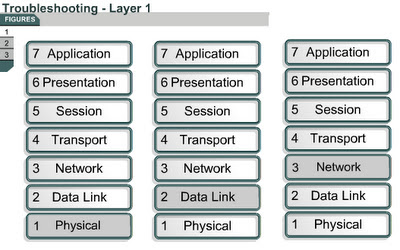Testing by OSI layers
9.2.3 This page will describe the types of errors that occur at the first three layers of the OSI model.
Layer 1 errors can include the following:
The next page will explain how indicator lights can be used to test a network.
9.2.3 This page will describe the types of errors that occur at the first three layers of the OSI model.
Layer 1 errors can include the following:
- Broken cables
- Disconnected cables
- Cables connected to the wrong ports
- Intermittent cable connection
- Rollover, crossover, or straight-through cables used incorrectly
- Transceiver problems
- DCE cable problems
- DTE cable problems
- Devices turned off
- Improperly configured serial interfaces
- Improperly configured Ethernet interfaces
- Improper encapsulation set
- Improper clockrate settings on serial interfaces
- Network interface card (NIC) problems
- Routing protocol not enabled
- Wrong routing protocol enabled
- Incorrect IP addresses
- Incorrect subnet masks
The next page will explain how indicator lights can be used to test a network.



No comments:
Post a Comment